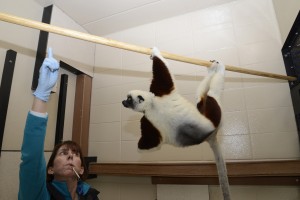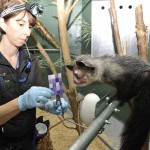March 28, 2014 — Earlier this week we went behind the scenes with IMAX to learn how the Duke Lemur Center’s animal training experts prepared five of our fat-tailed dwarf lemurs for their role in the upcoming IMAX film, Island of Lemurs: Madagascar. But animal training isn’t just for the movies. It’s critical for research and animal care too. In the following post, volunteer tour guide Scott Hennes teams up with Behavioral Manager Meg Dye to find out how she uses clickers and treats to build behaviors. Find out why training lemurs is important, and why it’s trickier than it looks:
 Just one more step to the right. Click-click. This isn’t too bad. My subject is learning nicely. Now just wait for a little change of direction. Quick, press the clicker again. No, wait. I clicked too late and I trained my subject to go the wrong way. Where’s the Undo button on this clicker?
Just one more step to the right. Click-click. This isn’t too bad. My subject is learning nicely. Now just wait for a little change of direction. Quick, press the clicker again. No, wait. I clicked too late and I trained my subject to go the wrong way. Where’s the Undo button on this clicker?
In her “Evening with the Experts” talk, Meg Dye, the Lemur Center animal behavior manager, led us through a behavioral training session which gave us a chance to try training each other. The technique is deceptively simple: wait until the person (your subject) begins the desired behavior, press the clicker, and then reward your subject with a food treat. Repeat the process to create a sequence of behaviors that produces the desired result. In practice, we found that it wasn’t this easy. At first, your subject has no idea what you want it to do. You need to make a lot of decisions about when to click to guide it closer and closer to your goal. If you mistime a click, you will train a behavior that you don’t want.
Behavioral training is a valuable tool in the management of the Lemur Center. It is less stressful for both the animals and their caregivers if the lemurs understand how to participate in their care. After training, lemurs will enter a transport crate, come to their keeper for an injection, perform physical therapy exercises, or allow veterinary palpation and ultrasound for pregnancy evaluation.
 Researchers spend their time more efficiently if their test subjects reliably produce the necessary behavior. A sifaka learned to follow his keeper so that he would walk back and forth across a pressure plate used by a researcher to study locomotion. Meg trained aye-ayes to select a blue square rather than a gray square in bright lighting, so that when the lights were progressively lowered, the aye-ayes would repeat their trained behavior to determine the threshold for distinguishing blue from gray.
Researchers spend their time more efficiently if their test subjects reliably produce the necessary behavior. A sifaka learned to follow his keeper so that he would walk back and forth across a pressure plate used by a researcher to study locomotion. Meg trained aye-ayes to select a blue square rather than a gray square in bright lighting, so that when the lights were progressively lowered, the aye-ayes would repeat their trained behavior to determine the threshold for distinguishing blue from gray.
All this from a few well-timed clicks and a lot of treats.
(For more examples of Lemur Center training, click here).
 Scott started out as a biologist with a biochemistry degree from the University of California at Davis. He then took a career-long detour through software development after receiving a MS in computer science from UNC, but has now returned to biology as a volunteer tour guide at the Lemur Center.
Scott started out as a biologist with a biochemistry degree from the University of California at Davis. He then took a career-long detour through software development after receiving a MS in computer science from UNC, but has now returned to biology as a volunteer tour guide at the Lemur Center.

